The heir of the Rising Sun - A Japan AAR
- Thread starter trekaddict
- Start date
-
We have updated our Community Code of Conduct. Please read through the new rules for the forum that are an integral part of Paradox Interactive’s User Agreement.
You are using an out of date browser. It may not display this or other websites correctly.
You should upgrade or use an alternative browser.
You should upgrade or use an alternative browser.
Gigalocus Rather just a ground commander than a propaganda minister who is unrealistic by definition. 
Hardraade wow, thats high praise.
Hardraade wow, thats high praise.
Chapter III
The Marco Polo Bridge incident pulled Japan into war. The League of Nations protested strongly at the Japanese intervention over a relatively minor incident and demanded a total withdrawal of all Japanese forces from northern China. Hirohito was enraged. He considered the China incident an internal Japanese matter and denied any jurisdiction by the League. When the League protested about this claim Japan walked out of the Assembly, never to return. Japan had become an outcast, but that was of no concern to anyone on the Japanese Home Islands and throughout the Empire.
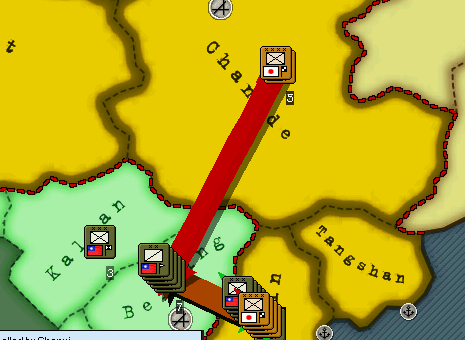
On the front things went better for Japan. The early phase of Ichi-Go went well, Bejing fell on july 6th, and was quickly occupied by Japanese forces. As expected Chinese resistance was fierce but ultimately futile and doomed to failure. Chinese troops put up a gallant and brave defence, utilizing the terrain to the fullest, but were hampered by their horribly outdated Great War eara Equipment and the superiority of the Japanese Doctrine. What really shattered both the Chinese will to resist and their acutal positions was the superb use of the light tanks of the 1. Japanese Mobile Army, which contianed all tanks the IJA had in its inventory. The tank support was essential by forcing the initial breakthough through the Chinese lines north of Beijing.
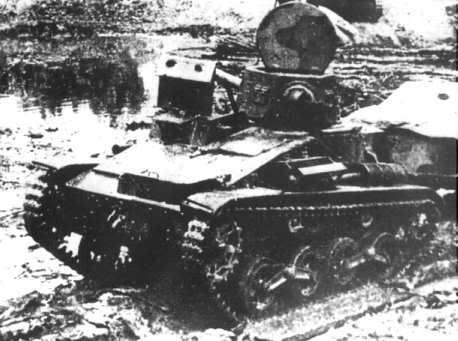
Japanese Type 94 in a field Army base in China
After the fall of Beijing the Japanese forces on the southern flank halted to reorganize. The supply situation was not good and worsening, (AN: there were times when I had less than 400 supply ) but this did not stop the Japanese troops. A few days later the advance was continued and soon, only three days behind the schedule, the Infantry units reached the southernmost line that had been set for the first days of Ichi-Go. The 1. Japanese Mobile Army, fondly called the “1. Mobile” by the population of Tokio where it hat its homebase, advanced south into Shiji azhuang. When the commander of the 1. Mobile radioed its capture to Tokio the Mongolian Army and the 5th Corps moved southwards. The resistance by the few scattered Chinese units in the area was quickly quelled, but the rough terrain and the worsening weather made for a slow advance. It took them four weeks to fully capture the province, and another 2 for the 5th corps to move southeast to link up with the advance guards of the 1. Mobile. When they finally linked in late September a healthy portion of the Chinese Northern Army was cut off with no hope of escaping destined to surrender or die. Chinese counterattacks on the ring around the pocket were repulsed and soon the pocket was shrinking and under constant attack by the IJAF tactical bombing wing.
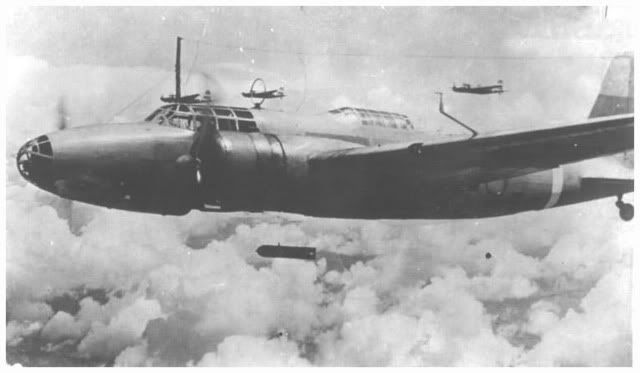
IJAF KI-21 bombing the chinese pocket
After the final destruction of the pocket in late 1937 the evaluation for the fighting showed that the number of destroyed divisions in the pocket was lower than hoped, but would nontheless cripple the Chinese Northern Army and hamper any coordinated Chinese counteroffensive until the next year, and by then Japanese reinforcements would pour into China anyways. The results were not as good as Tokio had hoped, but nontheless very good, and the report that was presented to the Emporer about the first months of war stated various reasons for the mixed success Japan had met so far: The Chinese Army had the numbers on its side, but was hopelessly oboslete in both doctrine and equipment. (AN: I’m already upgrading to 1939 INF and I have yet to see more than the occasional chinese 1936 INF. )
The IJA was mainly hampered by low numbers and the increasing partisan activity behind its lines. To combat this the IJSP approached several local leaders it had had contacts with since the late 1920's and "advised" them to form a local gouvernement that was to rule the southern mongolian provinces under Japanese protection which was formed at once and resumed office in alte November. On September 15th the Northern Army Group launched an attack meant to give the IJA a better position for the assault on the communist stronghold, and captured Taiyuan on November 27th. Immediate probing attacks showed that the Communist position, reinforced by nationalist troops was simply too strong for the rather limited Japanese forces and so the planned assault was put of until summer 1938 when the expected reinforcements would arrive. For now the IJA would simply besiege the Communists and concentrate all advances in the east were Yucheng had fallen a few days earlier. Some small local attacks were carried out, jsut to gain strategic territory in the next province but no major Japanese offensive materialized as the snow was already falling heavily and greatly hampering Japanese logistics in the mountainious areas of northern China. The High Command of the Imperial Japanese Army couldn't decide who to send to bring this bad news to the Emporer, but this discussion was rendered useless when Hirohito himself ordered all offensive operations to be stopped until next spring.
Nice going thus far in China, and a fine update too. I like the way that you are able to give a sense of the campaign as a whole.
Hardraade thanks. I'm trying to write it like it is a part of a history book, an intro chapter to certain parts or so.
stnylan That is going to take some time. China is veeeery large.
stnylan That is going to take some time. China is veeeery large.
Roman_legion Well, armour is always good for breaking through somewhere and encircling some enemy divisions. I just love encirclements.
It is evening and I felt like doing another update. Thats crappy german cable TV for you. I'm pretty nervous about the test I'm having tomorrow, (yes, i have studied ) so this updates quality might be a bit less thought through as the other ones.
The year 1938 started with the Japanese Army deep in China. Over the winter two new corps had been formed and sent to China, including the 6th corps. The pirmary mission for these two corps was to move south from Lianyungang and, with the assistance from the 1st Mobile to capture the Nationalist Capital of Nanjing. Hirohito, under advice from his Staff made this the top priority for the first half of the 1938 campaigning season, as the troopstrength in the western part of China still did not suffice to remove the Communist Chinese from their redoubts. It had originally been intended to use mountaineer Divisions to do the Job, but raising thos prved more difficult than expected as Japan lacked several critical technologies. (AN: my fault. I simply assumed that the tech was there. Imagine my surprise when i saw that they werent avaiable) So it was up to the regular infantry in support of the Cavalry, but that operation was still in the future. During the first months of 1938 the main fighting occured near the coast, with the Eastern Army Group moving south and some elements from the Middle Army Group protecting their flanks.
In September when the war entered its second year Hirohito made one of his rare speeches to the nation where he detailed the current situation of the war.
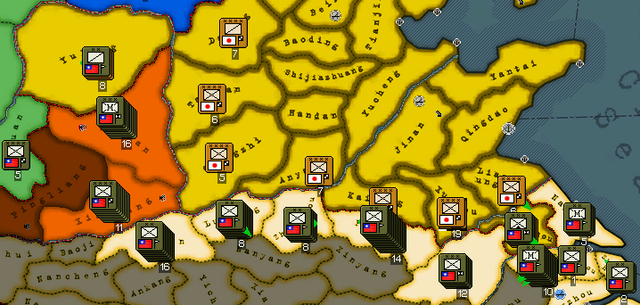
This is a reprint of the map used by Emporer Hirohito, the Original is on display in the Imperial museum in Tokio
The Capture of Nanjing had originally been sheduled for April 1938, but unexpectedly fierce Chinese resistance and several equally unxpectedly sucessfull Chinese counterattacks all over the front had slowed the Japanese advance down, slowing the advance to Nanjing to a crawl. General Kawabe M., Commander of the Eastern Army Group described it in his memoires as "as if a turtle would attempt to reach the water while beeing washed back onto the shore whenever it makes two steps forward." In the end the relentless Japanese attacks and their overwhelming Air Superiority payed off and in early september 1938 the Eastern Army group stood ready to begin the encirclement of the Chinese Capital. Kawabe M, both Commander of the Eastern Army Group and of the 6th Corps initiated the attack by capturing Hefei. It was expected that the capital would fall quickly but then a fierce Chinese counterattack removed the 6th Corps from the Province. The IJA immediately counterattacked and defeated the still arriving Chinese units, but lost almost all of its organization while doing so, and so it was not surprising that the following Chinese counterattack kicked the Japanese counterattack. This was the beginning of a struggle during which the province would change hands eleven times (AN: no I'm not kidding. I won and lost that province 11 times) The Japanese High Command, at first simply annoyed over loosing that province again and again soon considered it a matter of honor to take and hold that province and abandonned all other offensive operations that were supposed to have been launched during that period, among them the capture of Shanghai by an Amphibious assault. This back and forth continued during November. After a few weeks the Emporer was so annoyed by this delay that he personally called in the CP of the Eastern Army group and ordered the 1. Mobile to join the assault, "the integrity of the front be dammed.". The tanks proved to be a decicive factor once more and finally the province fell into Japanese hands for good. The 6th corps under Kawabe M quickly moved into Nanjing to plug the hole that had been torn open by the redeployment of the 1. Mobile. Then something terrible happened:
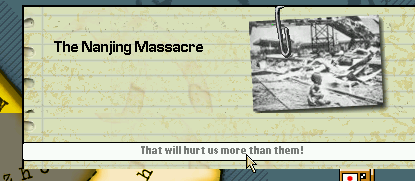
When the Emporer heard about this he virtually exploded in rage. He had no love for the Chinese, none at all, but slaughtering civillians was not only against the Bushido and therefore morally wrong, but also more than counterproductive in relation to his efforts to rebuild at least a part of Japans position in the community of Nations. Kawabe M recieved another call from the Emporer shortly after that massacre. What has been said is unknown to this day and will most likely remain so until all eternety, but as soon as he had hung up Kawabe M comitted sepukku. His body was returned to Japan and burned. His ashed were buried on a small cementery on Hokkaido as his family refused to take him in their family grave. His post as commander of the Eastern Army group was taken by an eager General named Tojo. He odered a quick attack south to take advantage of the Chinese confusion, and quickly captured shanghai and drove south. Meanwhile Navy Minister Yamamoto had finally scraped together enough assets to realize at least a part of his plan and launched an Amphibious invasion of Hainan Island in the south. This was all that was left from the great war plan that had been presented to the Emporer over one year earlier, but it still suceeded in binding a lot of warlord troops especially when the Army corps landed on the neighbouring mainland province. Save for some minor attacks in the north were the communists had fallen in early november after what had initially been planned as another probing attack, this was the last operation in China before 1938 ended.
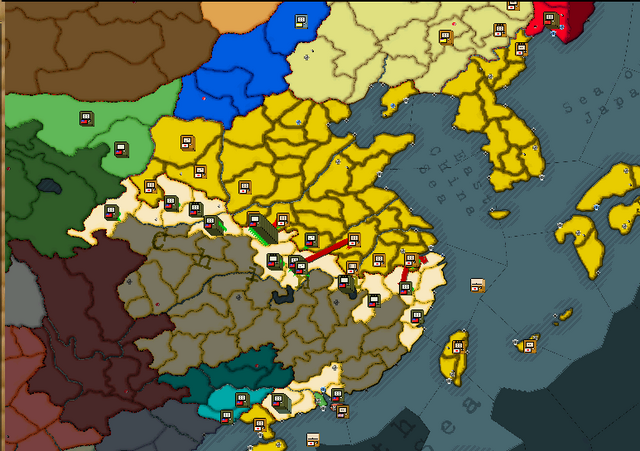
Chapter IV
The year 1938 started with the Japanese Army deep in China. Over the winter two new corps had been formed and sent to China, including the 6th corps. The pirmary mission for these two corps was to move south from Lianyungang and, with the assistance from the 1st Mobile to capture the Nationalist Capital of Nanjing. Hirohito, under advice from his Staff made this the top priority for the first half of the 1938 campaigning season, as the troopstrength in the western part of China still did not suffice to remove the Communist Chinese from their redoubts. It had originally been intended to use mountaineer Divisions to do the Job, but raising thos prved more difficult than expected as Japan lacked several critical technologies. (AN: my fault. I simply assumed that the tech was there. Imagine my surprise when i saw that they werent avaiable) So it was up to the regular infantry in support of the Cavalry, but that operation was still in the future. During the first months of 1938 the main fighting occured near the coast, with the Eastern Army Group moving south and some elements from the Middle Army Group protecting their flanks.
In September when the war entered its second year Hirohito made one of his rare speeches to the nation where he detailed the current situation of the war.

This is a reprint of the map used by Emporer Hirohito, the Original is on display in the Imperial museum in Tokio
The Capture of Nanjing had originally been sheduled for April 1938, but unexpectedly fierce Chinese resistance and several equally unxpectedly sucessfull Chinese counterattacks all over the front had slowed the Japanese advance down, slowing the advance to Nanjing to a crawl. General Kawabe M., Commander of the Eastern Army Group described it in his memoires as "as if a turtle would attempt to reach the water while beeing washed back onto the shore whenever it makes two steps forward." In the end the relentless Japanese attacks and their overwhelming Air Superiority payed off and in early september 1938 the Eastern Army group stood ready to begin the encirclement of the Chinese Capital. Kawabe M, both Commander of the Eastern Army Group and of the 6th Corps initiated the attack by capturing Hefei. It was expected that the capital would fall quickly but then a fierce Chinese counterattack removed the 6th Corps from the Province. The IJA immediately counterattacked and defeated the still arriving Chinese units, but lost almost all of its organization while doing so, and so it was not surprising that the following Chinese counterattack kicked the Japanese counterattack. This was the beginning of a struggle during which the province would change hands eleven times (AN: no I'm not kidding. I won and lost that province 11 times) The Japanese High Command, at first simply annoyed over loosing that province again and again soon considered it a matter of honor to take and hold that province and abandonned all other offensive operations that were supposed to have been launched during that period, among them the capture of Shanghai by an Amphibious assault. This back and forth continued during November. After a few weeks the Emporer was so annoyed by this delay that he personally called in the CP of the Eastern Army group and ordered the 1. Mobile to join the assault, "the integrity of the front be dammed.". The tanks proved to be a decicive factor once more and finally the province fell into Japanese hands for good. The 6th corps under Kawabe M quickly moved into Nanjing to plug the hole that had been torn open by the redeployment of the 1. Mobile. Then something terrible happened:

When the Emporer heard about this he virtually exploded in rage. He had no love for the Chinese, none at all, but slaughtering civillians was not only against the Bushido and therefore morally wrong, but also more than counterproductive in relation to his efforts to rebuild at least a part of Japans position in the community of Nations. Kawabe M recieved another call from the Emporer shortly after that massacre. What has been said is unknown to this day and will most likely remain so until all eternety, but as soon as he had hung up Kawabe M comitted sepukku. His body was returned to Japan and burned. His ashed were buried on a small cementery on Hokkaido as his family refused to take him in their family grave. His post as commander of the Eastern Army group was taken by an eager General named Tojo. He odered a quick attack south to take advantage of the Chinese confusion, and quickly captured shanghai and drove south. Meanwhile Navy Minister Yamamoto had finally scraped together enough assets to realize at least a part of his plan and launched an Amphibious invasion of Hainan Island in the south. This was all that was left from the great war plan that had been presented to the Emporer over one year earlier, but it still suceeded in binding a lot of warlord troops especially when the Army corps landed on the neighbouring mainland province. Save for some minor attacks in the north were the communists had fallen in early november after what had initially been planned as another probing attack, this was the last operation in China before 1938 ended.

I always keep thinking, that the Nat is stupid when they anex their allies 
Nice update tough.
Nice update tough.
haha a japanese general commiting suicide for being cruel?? i like this aar trekkie, any plans for the IJN?
Roman_legion So do I, but its maby to keep funny things from happening when the fall of the dragon event fires.
Capibara Yes, and its bound to get even faster. Once you've broken through the chinese lines north of nanjing its just a matter of time.
Funkatronica Well, this is a wiser Japan. Hirohito himself signed the orders that the Geneva convetnion is to be observed. Treating an enemy who has fought honorably well cant hurt in the post war relations.
Once this war is over the Army will face serious budget cuts. All of that will go into the IJN and the IJAF. We will see massive Japanese CV fleets not too far from now.
Capibara Yes, and its bound to get even faster. Once you've broken through the chinese lines north of nanjing its just a matter of time.
Funkatronica Well, this is a wiser Japan. Hirohito himself signed the orders that the Geneva convetnion is to be observed. Treating an enemy who has fought honorably well cant hurt in the post war relations.
Once this war is over the Army will face serious budget cuts. All of that will go into the IJN and the IJAF. We will see massive Japanese CV fleets not too far from now.
Chapter V
The Winter of 1938/1939 was not as quiet as the previous one. Unlike last winter this time the IJA did not lack the strength to make some pushes despite the winterly weather. The slakening Chinese resistance did its own to encourage the Japanese Soldiers who could see the light at the end of the Tunnel, sensing that the end of the war was near. For the first time since the war started, almost two years ago Hirohito was completely satisfied with the progress the Army made, and Tojo quickly capitalized on that support, knowing that once the war was over all the funding the Army had recieved to deal with the Chinese would go to the Navy and the Air Force, the Armys rivals. He met the Emporer in Tokio to make sure the Army got its share of the post war Military Budget that would be needed to keep the IJA up to par with possible future adversaries. Hirohito who had, without sucess, tried to repair the damage the Nanjing Massacre had do to the Japanese Position in the world said to Tojo: "General, the Allied Powers and the United States are like cunning dragons. They are building a chain of encirclement around Japan, waiting to jump us as soon as our backs are turned. We must be prepared." Tojo got his wish.
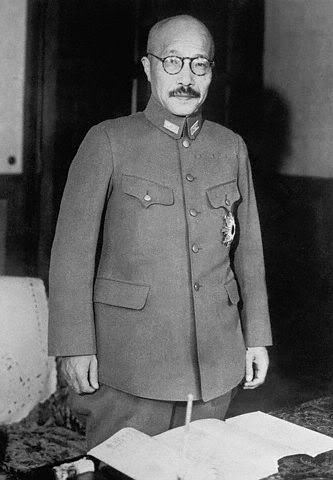
General Hideki Tojo after his meeting with the Emporer
Back in China the General studied the maps and saw an opportunity to capture much if not all of the remaining Chinese coastline without too much effort. The 6th Corps was in an ideal position to race down the coastline and possibly achieve a link-up with the bogged down forces from the landing at Hainan, and paving the way for a major push into the central regions of China, ending the war once and for all. He quickly reorganized his forces accordingly, with the 1. Mobile serving as his immediate flank guard and other, less fast Army Corps serving as rearguards, defending their supply lines to the north agains any possible Chinese counterattacks. He doubted that the remnants of the Chinese Army, mainly either totally outdated Infantry (AN: Its 1939, and they STILL have 1918 inf?
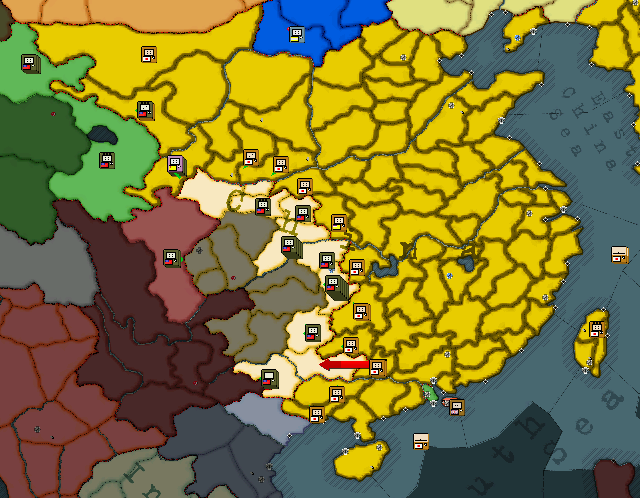
The Japanese pressed on even harder, seeing the end of this war before them, and om August 12th Chiang-Kai-Shek made a speech from an improvised platform in the provisory capital of the Chinese Republic:
Chiang-Kai-Shek said:Three Years ago the Japanese attacked our great nation. I promised never to give up the fight. Now, in August 1939, the military situation forces me to bear the unbearable, to think the unthinkable and offer the Republic of Chinas unconditional surrender to the Empire of Japan
The 2nd and last Sino-Japanese War was over. Chiang-Kai-Shek, who had announced the surrender dissapeared shortly after handing over his Office to General Tojo. He was supposed to be transported to Tokio, but managed to escape from the armoured car that was carrying him north with the help of loyalist Chinese citizens, although this would not be known until he resurfaced in the United States some years later, where he lived until his death in 1978.
China was occupied by the IJA, and once more Japan had to ask itself: "Where do we go form here?" One thing that the Japanese had learned from the War was that occupiing China directly was something not even worth considering, and so Hirohito once more shose the way of installing a puppet regime loyal to Tokio. This new Regime could become a danger for Japan in the future if Hirohito didnt watch out and so the "Independence Treaty" that was signed in the still wardamaged Nanjing in the same year clearly stated that all appointments higher than district gouvernour or higher an Colonel within the Army would neccesitate approval from the local Japanese Commander, and evne at the lower levels Japan had a lot of influence. This was the beginning of one of the biggest single bureaucratic entity on the Planet, the Imperial Japanes Burea for Chinese Matters. ( as of 1995 400.000 Japanese are working for the IJBCM )
--------------------------------------------------------------------------------------------------------------
This is just about as far as I have played right now. The next update will cover where Japan goes from there.
Despite the lack of feedback I'll post the next chapter. Much stuff has happened.
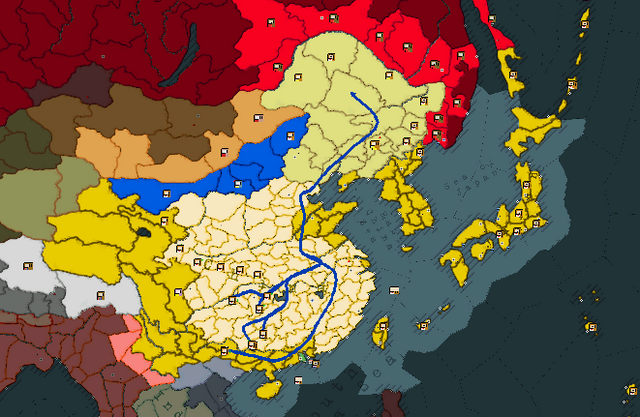
After the end of the "China Incident" as the 2nd Sino-Japanese war was called in Japan the Empire once more could concentrate on internal matters. The war had virtually destroyed all Japanese foreign relations, and all efforts to rebuild them failed miserably. Hirohito could see that sooner or later something needed to happen to prevent the collapse of the Japanese economy due to lack of resources. The old "Southern Resource Area" -warplan was dusted off and brought up to modern standards, but the IJN was not yet ready, CV construction was severly lagging behind and the only Special Naval Landing Force was not yet completed. These were the problems that troubleled the Emporer in late August 1939, but then once again Europe demanded the worlds attention. On August 24th, Hitler signed a non-agression treaty with his ideologichal arch-enemy, the Soviet Union. Six days later the Axis Alliance attacked poland, provoking a declaration of war from the Allied powers. War was engulfing Europe. However this was not the only thing that happened during these days. In South-East Asia trouble was brewing too. Siam, once a close friend and trading partner of the Japanese Empire had started to cut all relations to Japan in the Aftermath of the Nanjing Massacre and the trading had stopped. Hirohito, knowing that Japan needed the rare materials, Siams foremost export product and instructed the Japanese Embassy in Bangkok to make preparations for installing a more friendly Gouvernement, but these attempts were foiled before they could get started. Hirohito, not willing to wait until this was worked out decided to go a more direct route. He ordered the Japanese Ministry of Information to build a case for an armed intervention in Siam. The Ministry gladly obeyed the Emporers wish and blew a minor traffic accident where a driver from the Japanese Embassy had been killed by a Siamese motorist totally out of proportion and openly accused the Siamese gouvernement of 'ordering' the accident. The 1. Combined Fleet sortied from its Base at Nagasaki and steamed south towards the Bight of Bangkok to blockade the small Siamese Fleet in iths harbour. The incomplete 1. SNLF, working together with the 2nd IJA Corps was landed near Bangkok on January 3rd, 1940 and forced the Siamese gouvernement to flee somewhere to the Kra penninsula, leaving their army to defeat the Japanese near the Capital. The Siamese Army put up a brave show, but were simply outclassed by the battlehardened Japanese troops, and could, despite their superb use of the terrain only slow the Japanese down. The fight was decided from the start, but the Siamese defended their country valiantly letting the Japanese forces hunt them through the jungle for many weeks. In the end their resistance was futile and Siam ceased to exist.

The campaign had been decided upon and executed on such a short notice that the Allies couldnt react especially while they were preoccupied with Europe where Denmark and Norway had fallen to the Germans and were the Wehrmacht was building up at the border with Belgium and the Netherlands. Hirohito had gotten away with the conquest of Siam the Industry of which was now working for Japan. He was not fool though. He knew that any further agression would surely provoke a Allied or American response, maybe even both, and the 1. Combined Fleet was not ready to face the American Pacific fleet and the Royal Navy, despite recieving a new Carrier with two more laid down. Japan needed more preparation. Scientists and Engineers all over the Empire worked hard, and two projects drew so much attention from the Imperial Palace that Hirohizo himself visited both of them. One was at the Kure Naval yard where a team of Engineers was working on a new type of Battleship, bigger than anything ever seen before, the Super Yamato-Class Improved Super Heavy Battleships, based on a earlier design that had not been built.

The Model of the Super-Yamato used for tests in a flow-channel
The other one was in a small cave near Osaka.
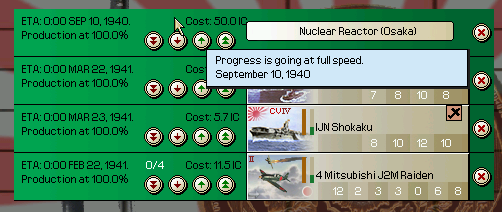
The Empire of Japan was preparing for war, a war larger and longer than the war against China, a war to the death.
EDIT: thanks for the comments.... I sort of missed them when I wrote the intro to this chapter.
forgot to mentoin: Japan has a pretty nice nuclear tech team btw, only level 4, but better than most of the other countries nuc teams.
Chapter VI

After the end of the "China Incident" as the 2nd Sino-Japanese war was called in Japan the Empire once more could concentrate on internal matters. The war had virtually destroyed all Japanese foreign relations, and all efforts to rebuild them failed miserably. Hirohito could see that sooner or later something needed to happen to prevent the collapse of the Japanese economy due to lack of resources. The old "Southern Resource Area" -warplan was dusted off and brought up to modern standards, but the IJN was not yet ready, CV construction was severly lagging behind and the only Special Naval Landing Force was not yet completed. These were the problems that troubleled the Emporer in late August 1939, but then once again Europe demanded the worlds attention. On August 24th, Hitler signed a non-agression treaty with his ideologichal arch-enemy, the Soviet Union. Six days later the Axis Alliance attacked poland, provoking a declaration of war from the Allied powers. War was engulfing Europe. However this was not the only thing that happened during these days. In South-East Asia trouble was brewing too. Siam, once a close friend and trading partner of the Japanese Empire had started to cut all relations to Japan in the Aftermath of the Nanjing Massacre and the trading had stopped. Hirohito, knowing that Japan needed the rare materials, Siams foremost export product and instructed the Japanese Embassy in Bangkok to make preparations for installing a more friendly Gouvernement, but these attempts were foiled before they could get started. Hirohito, not willing to wait until this was worked out decided to go a more direct route. He ordered the Japanese Ministry of Information to build a case for an armed intervention in Siam. The Ministry gladly obeyed the Emporers wish and blew a minor traffic accident where a driver from the Japanese Embassy had been killed by a Siamese motorist totally out of proportion and openly accused the Siamese gouvernement of 'ordering' the accident. The 1. Combined Fleet sortied from its Base at Nagasaki and steamed south towards the Bight of Bangkok to blockade the small Siamese Fleet in iths harbour. The incomplete 1. SNLF, working together with the 2nd IJA Corps was landed near Bangkok on January 3rd, 1940 and forced the Siamese gouvernement to flee somewhere to the Kra penninsula, leaving their army to defeat the Japanese near the Capital. The Siamese Army put up a brave show, but were simply outclassed by the battlehardened Japanese troops, and could, despite their superb use of the terrain only slow the Japanese down. The fight was decided from the start, but the Siamese defended their country valiantly letting the Japanese forces hunt them through the jungle for many weeks. In the end their resistance was futile and Siam ceased to exist.

The campaign had been decided upon and executed on such a short notice that the Allies couldnt react especially while they were preoccupied with Europe where Denmark and Norway had fallen to the Germans and were the Wehrmacht was building up at the border with Belgium and the Netherlands. Hirohito had gotten away with the conquest of Siam the Industry of which was now working for Japan. He was not fool though. He knew that any further agression would surely provoke a Allied or American response, maybe even both, and the 1. Combined Fleet was not ready to face the American Pacific fleet and the Royal Navy, despite recieving a new Carrier with two more laid down. Japan needed more preparation. Scientists and Engineers all over the Empire worked hard, and two projects drew so much attention from the Imperial Palace that Hirohizo himself visited both of them. One was at the Kure Naval yard where a team of Engineers was working on a new type of Battleship, bigger than anything ever seen before, the Super Yamato-Class Improved Super Heavy Battleships, based on a earlier design that had not been built.

The Model of the Super-Yamato used for tests in a flow-channel
The other one was in a small cave near Osaka.

The Empire of Japan was preparing for war, a war larger and longer than the war against China, a war to the death.
EDIT: thanks for the comments.... I sort of missed them when I wrote the intro to this chapter.
forgot to mentoin: Japan has a pretty nice nuclear tech team btw, only level 4, but better than most of the other countries nuc teams.
wow any war against the allies is going to be fascinating with a 50 IC weight around your neck for a while!!
have you got many naval bombers? they'll be of use if the IJN isnt up to scratch yet
have you got many naval bombers? they'll be of use if the IJN isnt up to scratch yet

